To old school computing bods like us, it doesn’t seem that long ago that floppy disks were the main way you lugged your data around.
 With its feeble 1.44MB storage space, that often meant you had to cart around great boxes of the things.
With its feeble 1.44MB storage space, that often meant you had to cart around great boxes of the things.
And with its gnat-like storage capacity, installing programs like Photoshop meant a lengthy spell sat by your machine, patiently feeding in a vast amount of grinding floppies and hoping that the last one in wouldn’t display a dastardly disk error.
Come 1994, the hi tech hotshots around town were sporting Iomega Zip drives, which served up a comparatively capacious 100MB of storage space (rising to 750MB in the final versions).
Although we felt the love for the increased capacity, the drive was quite a bulky beast, the disks weren’t cheap and folks lived in fear of suffering the dreaded click of death.
By the late 1990s, recordable CDs, cheap flash memory and external hard drives had become the modus operandi for portable storage users, although bigger and bigger files meant that the things soon filled up.
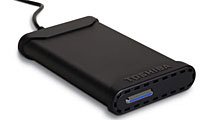 With this in mind, Toshiba – the world’s fifth-largest hard drive manufacturer – has decided to elbow its way into the portable drive market with its 2.5-inch USB 2.0 portable external hard drive offering a positively palatial 200GB of storage space. That works out at 57,000 digital photos, 52,000 MP3 songs or 88 DVD videos all wedged into its slimline case (approx 6″x4″x0.9″).
With this in mind, Toshiba – the world’s fifth-largest hard drive manufacturer – has decided to elbow its way into the portable drive market with its 2.5-inch USB 2.0 portable external hard drive offering a positively palatial 200GB of storage space. That works out at 57,000 digital photos, 52,000 MP3 songs or 88 DVD videos all wedged into its slimline case (approx 6″x4″x0.9″).
Claimed to offer the highest capacity of any backup solution in the compact 2.5-inch hard drive class, the 200GB beastie comes clad in a sleek vented black aluminum exterior, backed by a patent-pending shock mount system for extra protection.
The USB 2.0 drive also comes bundled with the NTI Shadow software which makes it a cinch to set up a back up schedule.
The full range of drives come in 200GB, 160GB, 120GB and 100GB capacities and the pricing looks good too, with suggested retail prices running from $229.99 (£115) for the 200GB model down to $129.99 (£65) for the 100GB.
 Intel is getting ready to release its own version of the mini-tablet, with
Intel is getting ready to release its own version of the mini-tablet, with 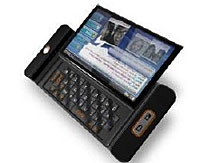 Expected to be released next year, the UMPCs are tipped to be an extension of the successful Centrino mobile brand, with the CPU components (codenamed Stealey) packing dual-core processors clocked at 600-800MHz.
Expected to be released next year, the UMPCs are tipped to be an extension of the successful Centrino mobile brand, with the CPU components (codenamed Stealey) packing dual-core processors clocked at 600-800MHz.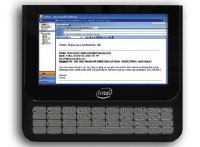 Intel’s new gizmo is looking to woo punters with a seductive mobile mix of email, web, entertainment, information and location-based services, including the trusty Google Maps application and Web-based “office and enterprise applications.”
Intel’s new gizmo is looking to woo punters with a seductive mobile mix of email, web, entertainment, information and location-based services, including the trusty Google Maps application and Web-based “office and enterprise applications.” A planned rollout will veritably bathe the City in luverly Wi-Fi rays, letting around 350,000 workers wander all over the Square Mile with uninterrupted wireless access.
A planned rollout will veritably bathe the City in luverly Wi-Fi rays, letting around 350,000 workers wander all over the Square Mile with uninterrupted wireless access. “We have been meeting a lot of the big financial institutions in the area and have even found that the network is available in a lot of their boardrooms, so we think there will be a corporate use for it as well,” he added.
“We have been meeting a lot of the big financial institutions in the area and have even found that the network is available in a lot of their boardrooms, so we think there will be a corporate use for it as well,” he added.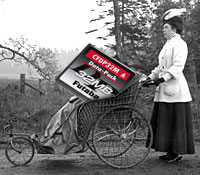 The two companies have revealed details about their Memorandum of Understanding (MOU) to develop a new SxS memory card format for professional camcorders.
The two companies have revealed details about their Memorandum of Understanding (MOU) to develop a new SxS memory card format for professional camcorders.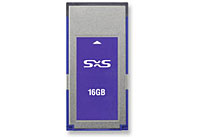 Although the card is too much of a heffalump to fit into digital compact cameras, it may appear in some high end medium format still cameras and other specialised snappers.
Although the card is too much of a heffalump to fit into digital compact cameras, it may appear in some high end medium format still cameras and other specialised snappers. We think that given the Mac OS is based on a form of Unix, and Apples dislike for Microsoft, it’s surprising that Apple hasn’t released a Linux-based server.
We think that given the Mac OS is based on a form of Unix, and Apples dislike for Microsoft, it’s surprising that Apple hasn’t released a Linux-based server. The Final Cut Studio 2 package includes Final Cut Pro 6, Motion 3, Soundtrack Pro 2, Compressor 3, DVD Studio Pro 4.2 and a new app called Color, described as a, “professional colour grading and finishing application.”
The Final Cut Studio 2 package includes Final Cut Pro 6, Motion 3, Soundtrack Pro 2, Compressor 3, DVD Studio Pro 4.2 and a new app called Color, described as a, “professional colour grading and finishing application.”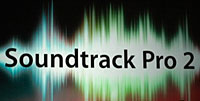 The Soundtrack Pro 2 audio editor adds tools for multitrack editing and surround mixing with a new Conform tool which makes it easier to precisely align effects and dialogue with footage.
The Soundtrack Pro 2 audio editor adds tools for multitrack editing and surround mixing with a new Conform tool which makes it easier to precisely align effects and dialogue with footage.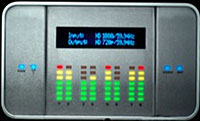 Finishing off the package is DVD Studio Pro 4.2 which takes care of SD and HD DVD authoring.
Finishing off the package is DVD Studio Pro 4.2 which takes care of SD and HD DVD authoring. Also a single network would have meant it could go to many more of the 5,600 DLEs than the 1,200 everyone’s competing for at the moment.
Also a single network would have meant it could go to many more of the 5,600 DLEs than the 1,200 everyone’s competing for at the moment. The Palm Backup Beta service can be downloaded
The Palm Backup Beta service can be downloaded  An activation letter is sent to your email account, but you can start the back up on your Treo straight away (but you must activate your Palm account within 7 days otherwise your account will be closed).
An activation letter is sent to your email account, but you can start the back up on your Treo straight away (but you must activate your Palm account within 7 days otherwise your account will be closed).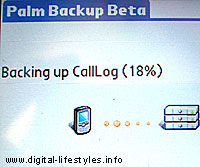 A back up of your data will then be saved to Palm’s secure server as scheduled – so long as there is wireless data coverage available (if it fails to find a connection, it will try again at the next scheduled time).
A back up of your data will then be saved to Palm’s secure server as scheduled – so long as there is wireless data coverage available (if it fails to find a connection, it will try again at the next scheduled time).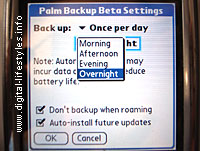
 Palm Backup Beta service currently supports Palm Treo 700p, Treo 680 and Treo 650 and there’s no news yet about release date or pricing.
Palm Backup Beta service currently supports Palm Treo 700p, Treo 680 and Treo 650 and there’s no news yet about release date or pricing.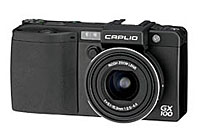 Never a company to run with the pack, the new Ricoh Caplio GX100 serves up an innovative feature set, with a super wide 24 to 72 mm wide zoom lens (35mm film equivalent), a fast F2.5 aperture and 10.01 Megapixel CCD sensor.
Never a company to run with the pack, the new Ricoh Caplio GX100 serves up an innovative feature set, with a super wide 24 to 72 mm wide zoom lens (35mm film equivalent), a fast F2.5 aperture and 10.01 Megapixel CCD sensor.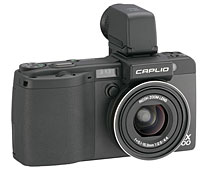 Another innovation that has set photo-nerd hearts a-fluttering in Chez Digi Lifestyles is the optional removable electronic viewfinder.
Another innovation that has set photo-nerd hearts a-fluttering in Chez Digi Lifestyles is the optional removable electronic viewfinder. As with the GR, macro focussing goes all the way down to a frankly ridiculous 1 cm (any closer and you’ll be burrowing into the subject), with a built in CCD shift method offering vibration reduction.
As with the GR, macro focussing goes all the way down to a frankly ridiculous 1 cm (any closer and you’ll be burrowing into the subject), with a built in CCD shift method offering vibration reduction. With the Ricoh Caplio GX100 measuring up at just 25mm, this looks to be a great carry everywhere camera, and with a claimed battery life of 380 exposures, this looks to be a very, very interesting camera.
With the Ricoh Caplio GX100 measuring up at just 25mm, this looks to be a great carry everywhere camera, and with a claimed battery life of 380 exposures, this looks to be a very, very interesting camera. Memory SD Memory Card ( 32, 64, 128, 256, 512 MB, 1, 2 GB), SDHC Memory Card (4 GB),
Memory SD Memory Card ( 32, 64, 128, 256, 512 MB, 1, 2 GB), SDHC Memory Card (4 GB),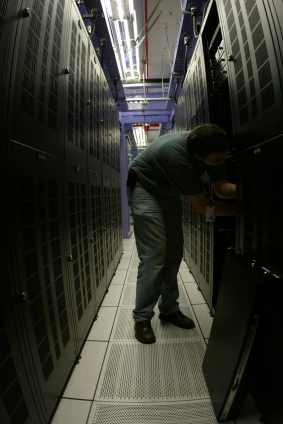 Since the operators all want to get into the same exchanges, there’s overcrowding and BT have to install new hostel space (the space where operators can put their own equipment into) which causes delays. It can take more than 6 months from when an operator puts an order in to being granted access to an exchange.
Since the operators all want to get into the same exchanges, there’s overcrowding and BT have to install new hostel space (the space where operators can put their own equipment into) which causes delays. It can take more than 6 months from when an operator puts an order in to being granted access to an exchange. Unfortunately the economics of LLU only work if there’s a lot of customers per exchange i.e. massive scale.
Unfortunately the economics of LLU only work if there’s a lot of customers per exchange i.e. massive scale.